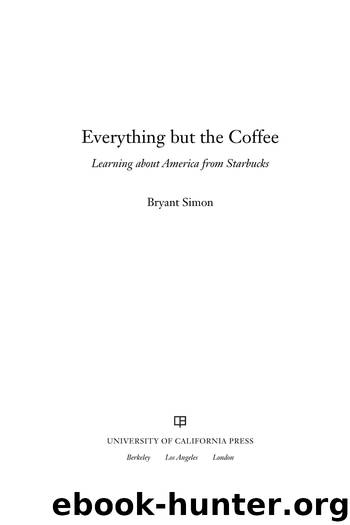Everything but the Coffee by Simon Bryant

Author:Simon, Bryant
Language: eng
Format: epub
ISBN: 9780520945173
Publisher: University of California Press
HALLEY’S COMET AND BEYOND
In 2004, Halley’s Comet hit. That’s what Brewster called Ray Charles’s Concord Records/Hear Music-produced CD, Genius Loves Company. Timed to come out at the same time as the red carpet release of the studio-made bio-pic Ray, the collection featured duets—often recorded in distant studios—with the R&B legend and Alison Krauss, Norah Jones, James Taylor, Elton John, Gladys Knight, and a few others. Unlike Charles’s sizzling Atlantic Records sessions of the early 1960s, these songs have a quiet, almost subdued feel, in part because Charles was ill when he cut most of the tracks. In fact, Charles died before the film came out and before the CD was officially released. Many, it seemed, mourned the singer’s death by buying the disc. Starbucks went on to sell seven hundred thousand units at full price of Genius Loves Company, helping it become a platinum-selling record and Charles’s biggest-selling CD of all time. The disc also won eight Grammy Awards.18
The bottom-line guys at Starbucks headquarters, presumably the ones who came from Pathmark and 7-Eleven, looked at the Genius Loves Company phenomenon, Brewster believes, as a “benchmark, not an aberration.” They wanted to repeat the performance again and again, driving up revenues and bolstering same-store sales, a figure closely followed on Wall Street that measures ongoing revenues at fast-food units opened for more than a year. Stock prices could rise or fall with small jumps or slight declines in this number. CD sales, like sales of breath mints, breakfast sandwiches, and stuffed animals, could keep same-store sales numbers moving up even when coffee purchases stagnated. According to Brewster, the role of music changed as a result. Artists and tunes no longer served essentially as brand builders—as ways to create a feeling of authenticity and an aura of discovery to match the coffee. Now company officials wanted the music to generate revenues and pump up the value of the stock.
Howard Schultz tapped Ken Lombard, who worked alongside Magic Johnson in the basketball star’s many post-hoops commercial ventures— including his opening of “urban” coffee shops in African American neighborhoods with Starbucks—as the architect of Starbucks’ musical makeover. While Lombard knew business, he didn’t know all that much about Rolling Stone–style FM music. He certainly didn’t spend his college years making mixed tapes for dorm mates at a private New England school. One company watcher told journalist David Margolick in 2008 that when Lombard took over Hear Music, he had never listened to The Who and thought Steely Dan was a person.19 But these gaps in his listening experience didn’t stop Lombard from trying to engineer a seismic shift in the geography of music buying for his target audience of upper-middle-class white professionals and their emulators.
A few years after effectively replacing Don MacKinnon at Hear Music, Lombard told music journalist Dan DeLuca that he wanted Starbucks to move from a “niche player” into a “destination when it comes to discovering new music.” As this move started to take shape, discovery went the way of coffee and a third place.
Download
This site does not store any files on its server. We only index and link to content provided by other sites. Please contact the content providers to delete copyright contents if any and email us, we'll remove relevant links or contents immediately.
Cecilia; Or, Memoirs of an Heiress — Volume 1 by Fanny Burney(32503)
Cecilia; Or, Memoirs of an Heiress — Volume 2 by Fanny Burney(31913)
Cecilia; Or, Memoirs of an Heiress — Volume 3 by Fanny Burney(31898)
The Great Music City by Andrea Baker(31759)
We're Going to Need More Wine by Gabrielle Union(19004)
All the Missing Girls by Megan Miranda(15787)
Pimp by Iceberg Slim(14438)
Bombshells: Glamour Girls of a Lifetime by Sullivan Steve(14024)
For the Love of Europe by Rick Steves(13628)
Talking to Strangers by Malcolm Gladwell(13297)
Norse Mythology by Gaiman Neil(13281)
Fifty Shades Freed by E L James(13189)
Mindhunter: Inside the FBI's Elite Serial Crime Unit by John E. Douglas & Mark Olshaker(9266)
Crazy Rich Asians by Kevin Kwan(9224)
The Lost Art of Listening by Michael P. Nichols(7456)
Enlightenment Now: The Case for Reason, Science, Humanism, and Progress by Steven Pinker(7274)
The Four Agreements by Don Miguel Ruiz(6704)
Bad Blood by John Carreyrou(6584)
Weapons of Math Destruction by Cathy O'Neil(6220)
